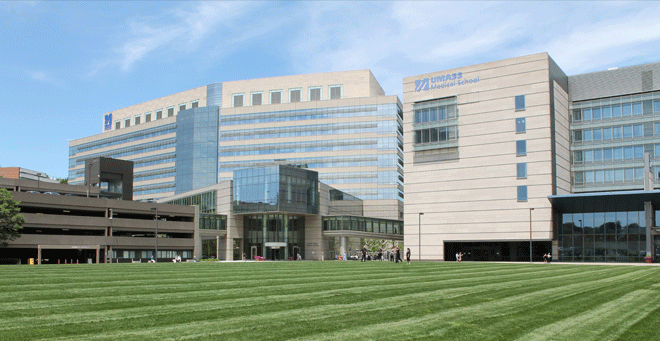 |
|
|
UMMS has been listed near the top of the category since 1994 when the magazine began publishing the rankings. U.S. News also ranked UMMS 52 among research schools. |
UMass Medical School was once again ranked in the top 10 percent in primary care education, coming in 16th among 140 medical schools and 30 schools of osteopathic medicine surveyed by weekly news magazine U.S. News & World Report in its 2017 edition of the “Best Graduate Schools” issue. UMMS has been listed near the top of the category since 1994 when the magazine began publishing the rankings. U.S. News also ranked UMMS 52 among research schools.
“UMass Medical School’s commitment to primary care education means that each year, there are more exceptional physicians caring for patients in underserved areas around the state and across the country,” said Chancellor Michael F. Collins. “The recognition is especially meaningful this year, as we expand our class size and open our first regional campus, UMMS-Baystate in Springfield, which will be home to a new educational track centered on rural and urban primary care, population health and integrated health management.”
The School of Medicine is expanding its current cohort of 125 students to 150 over the course of the next two academic years as UMMS, Baystate Health and UMass Amherst open a regional clinical campus of the medical school in Springfield. Students will begin enrolling in this track in the 2017-18 academic year, and will complete their basic science courses at the Worcester campus while completing their clinical requirements at the UMMS-Baystate campus. The expansion will increase access to students seeking an affordable medical education; respond to the health care needs of the commonwealth by increasing the number of Massachusetts physicians trained in urban and rural primary care; and apply proven academic research to improve population health, reduce health disparities and make health care better integrated, more efficient and more effective.
“UMass Medical School continues to be recognized as a world-class academic health sciences center for advances the faculty, staff and students make every day through pioneering education, research and health care delivery,” said University of Massachusetts President Marty Meehan. “Since its founding in 1962, it has not wavered from its vision of service.”
More than 50 percent of each year’s graduating class from the School of Medicine enter primary care residency programs. Additionally, more than half of each class stays in Massachusetts for residency, which has resulted in more than 300 new residents in the last five years alone.
“What distinguishes the School of Medicine most is the tireless dedication of our faculty and students to our core missions of education, research and patient care,” said Terence R. Flotte, MD, theCelia and Isaac Haidak Professor of Medical Education, executive deputy chancellor, provost and dean of the School of Medicine. “The size and breadth of our research enterprise continues to grow, which has a positive impact on the health of people around the world.”
U.S. News & World Report surveyed and ranked 140 medical schools accredited in 2015 by the Liaison Committee on Medical Education and 30 schools of osteopathic medicine accredited by the American Osteopathic Association based on measures of academic quality, which are weighted by reputation among faculty and residents, research activity, student selectivity and faculty resources.
Related links on UMassMedNow:
U.S. News & World Report ranks UMMS 12th in primary care